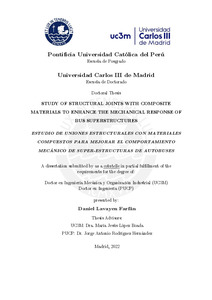| dc.contributor.advisor | Rodríguez Hernández, Jorge Antonio | |
| dc.contributor.author | Lavayen Farfán, Daniel | |
| dc.date.accessioned | 2022-09-22T19:00:39Z | |
| dc.date.available | 2022-09-22T19:00:39Z | |
| dc.date.created | 2022 | |
| dc.date.issued | 2022-09-22 | |
| dc.identifier.uri | http://hdl.handle.net/20.500.12404/23385 | |
| dc.description.abstract | Steel structures have an ubiquitous presence in several industries due to their availability
and low price. Bus super-structures are typically built using structural steel hollow
shapes and serve a major role during crashes and rollovers, as they protect the passengers
by absorbing the kinetic energy of impacts and dissipating it as plastic deformations. In
recent years, composite materials have gained protagonism in numerous applications due
to their high specific strength and stiffness. However, costs and manufacturing complexity
have made all-composite automotive structures economically unfeasible. Thus, the current
tendency is the use of multimaterial structures: using composites only in the zones
where they are needed, while keeping an inexpensive material, like steel, elsewhere. Hollow
structural shapes, used in bus structures, are susceptible to bending collapse failure
during rollover and crashes, which must be precisely predicted and calculated. Existing
theoretical models for this failure mechanism have certain limitations to account for larger
thickness, plastic hardening, and composite reinforcements. The present work aims to address
these limitations through the development of new theoretical models for the so-called
medium-thin-walled hollow shapes, as well as for reinforced CFRP-Steel hollow shapes.
Both materials are joined using structural adhesives due to their ease-of-use and relatively
low price. Experimental test results have shown the validity and accuracy of the proposed
models. These proposed models are then implemented in a concept model of a bus
structure to address its crashworthiness and the effectiveness of the reinforced shapes. | es_ES |
| dc.language.iso | eng | es_ES |
| dc.publisher | Pontificia Universidad Católica del Perú | es_ES |
| dc.rights | info:eu-repo/semantics/openAccess | es_ES |
| dc.rights.uri | http://creativecommons.org/licenses/by/2.5/pe/ | * |
| dc.subject | Autobuses--Estructuras de acero | es_ES |
| dc.subject | Autobuses--Carrocería--Mejoramiento | es_ES |
| dc.subject | Carrocería--Uniones soldadas--Modelos | es_ES |
| dc.title | Study of structural joints with composite materials to enhance the mechanical response of bus superstructures | es_ES |
| dc.type | info:eu-repo/semantics/doctoralThesis | es_ES |
| thesis.degree.name | Doctor en Ingeniería | es_ES |
| thesis.degree.level | Doctorado | es_ES |
| thesis.degree.grantor | Pontificia Universidad Católica del Perú. Escuela de Posgrado | es_ES |
| thesis.degree.discipline | Ingeniería | es_ES |
| renati.advisor.dni | 06510894 | |
| renati.advisor.orcid | https://orcid.org/0000-0002-5161-7196 | es_ES |
| renati.author.dni | 72965380 | |
| renati.discipline | 732028 | es_ES |
| renati.juror | Díaz López, Vicente | es_ES |
| renati.juror | Muñoz Sanz, José Luis | es_ES |
| renati.juror | Alencastre Miranda, Jorge Hernán | es_ES |
| renati.level | https://purl.org/pe-repo/renati/level#doctor | es_ES |
| renati.type | https://purl.org/pe-repo/renati/type#tesis | es_ES |
| dc.publisher.country | PE | es_ES |
| dc.subject.ocde | https://purl.org/pe-repo/ocde/ford#2.00.00 | es_ES |






